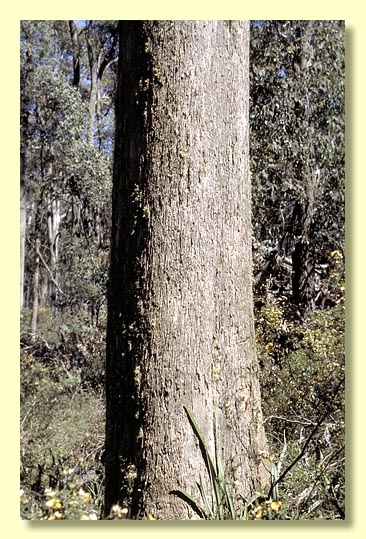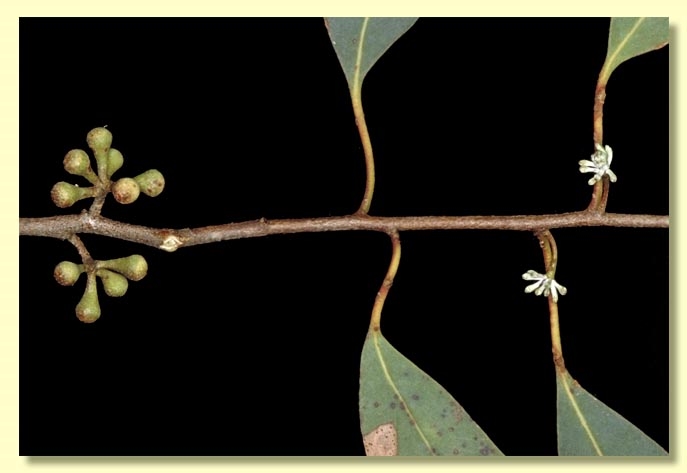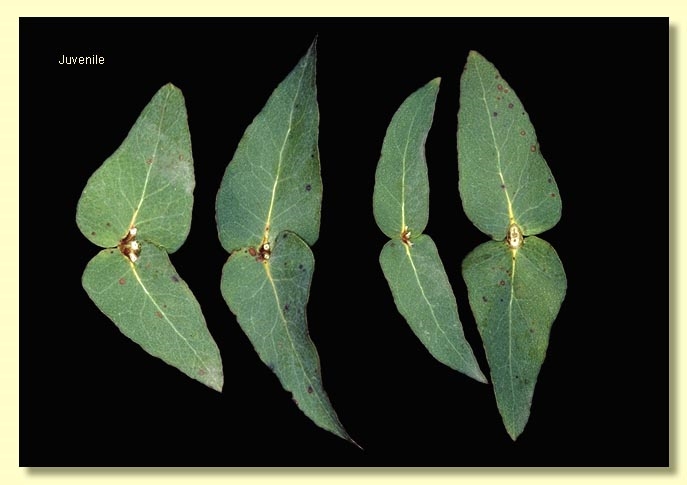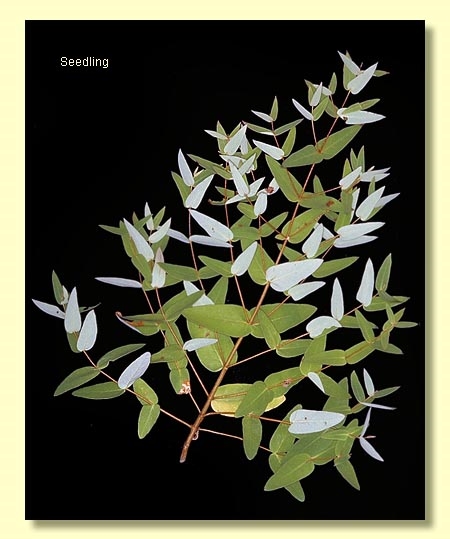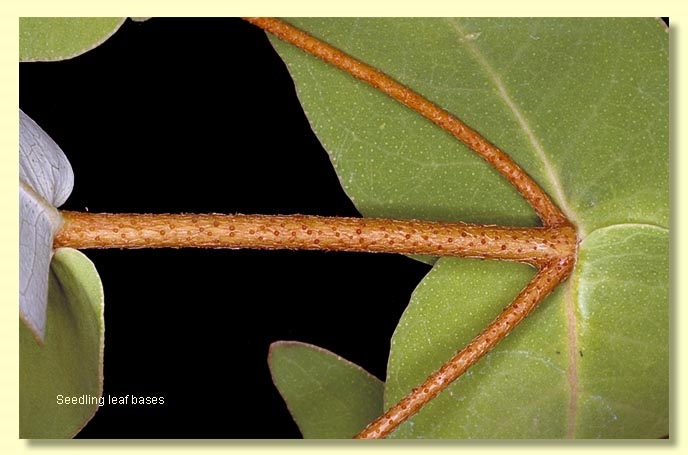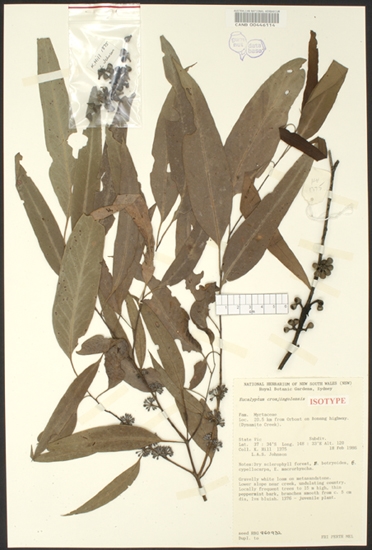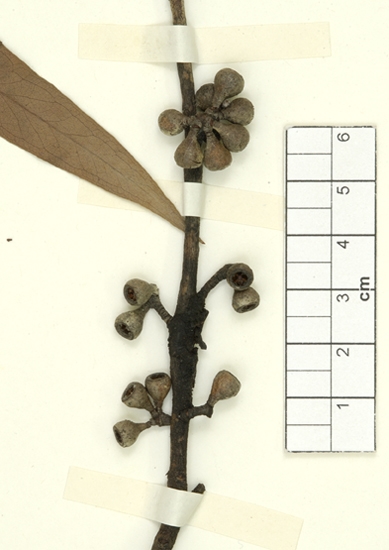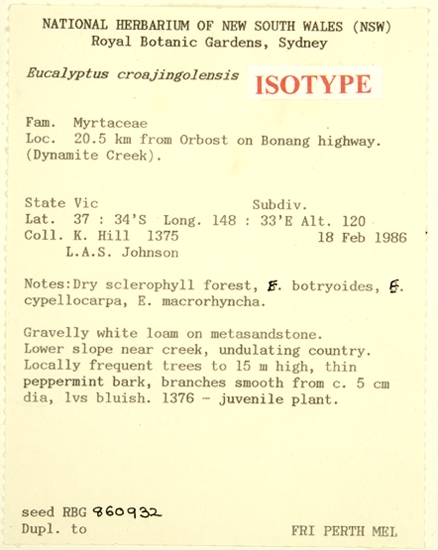Euclid - Online edition
Eucalyptus croajingolensis
Eucalyptus | Eucalyptus | Aromatica | Radiatae
Bark rough throughout or branches less than 8 cm diameter smooth; rough bark finely fibrous (peppermint-type), grey or grey-brown; smooth bark white or grey, often with scribbles, branchlets glaucous or non-glaucous.
Juvenile growth (coppice or field seedlings to 50 cm): stem rounded in cross-section, warty; juvenile leaves opposite, sessile, lanceolate to ovate, 4–9 cm long, 1.3–3.2 cm wide, grey-green or green. New growth tips on coppice and in mature crowns conspicuously pink-brown, non-glaucous.
Adult leaves opposite or alternate, petiole 1–2.5 cm long; blade lanceolate to falcate, 8–18 cm long, 1.2–4.2 cm wide, base oblique or tapering to petiole, concolorous, dull, blue-grey, grey-green or green, side-veins acute, sparsely to moderately reticulate, intramarginal vein parallel to and well removed from margin, oil glands island.
Inflorescence axillary unbranched, peduncles 0.3–1.5 cm long, buds 9 to 19 (?or more) per umbel, pedicels 0.1–0.5 cm long. Mature buds obovoid or clavate, 0.3–0.5 cm long, 0.2–0.3 cm wide, glaucous when young, maturing green, scar absent, operculum usually conical to rounded, stamens inflexed or irregularly flexed, anthers reniform to cordate, versatile, dorsifixed, dehiscing by confluent slits (usually), style short or long, stigma blunt or tapered, locules 3 or 4, the placentae each with 2 vertical ovule rows. Flowers white.
Fruit pedicellate (pedicels 0.1–0.4 cm long), hemispherical, truncate-globose or cup-shaped, 0.4–0.6 cm long, 0.4–0.6 cm wide, sometimes glaucous, disc level or descending, valves 3 or 4, near rim level or enclosed.
Seeds dark brown or reddish brown, 1–2.5 mm long, pyramidal or obliquely pyramidal, dorsal surface smooth, hilum terminal.
Cultivated seedlings (measured at ca node 10): cotyledons reniform; stems rounded in cross-section, warty; leaves sessile and opposite for many nodes, cordate to lanceolate, 3–8.5 cm long, 1–4 cm wide, base amplexicaul, dull, blue-green to grey-green.
Flowering has been recorded in January and December.
A small to medium-sized tree of eastern Victoria mostly south of the Dividing Range, commonly east of Bairnsdale on alluvial soils, but extending west to Marysville at a higher altitude, also in far south-east New South Wales near Mt Imlay.
A peppermint, Eucalyptus croajingolensis is characterised by the crown of thin-textured, dull, bluish, rather broad leaves which distinguish it from the widespread non-glaucous E. radiata subsp. radiata, the green and glossy-leaved E. dives, and the more restricted, more southern E. willisii subsp. willisii, a green-leaved peppermint which occurs in South Gippsland including Wilsons Promontory, and E. arenicola which occurs east from Rosedale and Loch Sport to Bairnsdale. Saplings of E. croajingolensis are often pendulous, and buds are usually glaucous. In the west of its range, E. croajingolensis may have a greener crown and non-glaucous buds (e.g. west of Mt Skene and Mt Useful and at higher altitudes near Marysville). In these areas it is best distinguished from the valley dwelling E. radiata subsp. radiata by adult leaf width and altitude of occurrence. In some parts of South Gippsland (e.g. Near Yarram), E. croajingolensis occurs on white sands with Banksia serrata, and may have extremely glaucous buds.
Eucalyptus croajingolensis belongs to Eucalyptus subgenus Eucalyptus section Aromatica (the peppermints) because the buds have a single operculum, anthers are reniform, ovules are in two rows, seeds are ± pyramidal, adult leaf venation is acute and juvenile leaves are sessile and opposite for many pairs. Within this section five closely related species form series Radiatae, viz. E. elata, E. radiata (with three subspecies), E. croajingolensis, E. willisii (with two subspecies), and E. dives. They differ from each other in bark and leaf characteristics, and, as a group, series Radiatae differs from the endemic Tasmanian peppermints, series Insulanae, by having numerous oil glands in the juvenile leaves.


